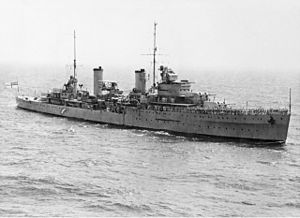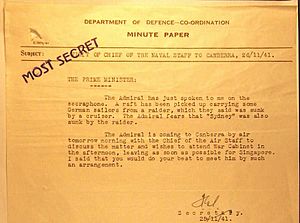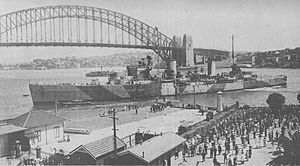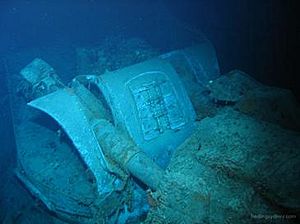HMAS Sydney (D48) facts for kids

HMAS Sydney under way in 1940
|
|
Quick facts for kids History |
|
|---|---|
| Name | Sydney |
| Namesake | Sydney, Australia |
| Builder | Swan Hunter & Wigham Richardson, Wallsend-on-Tyne, England |
| Laid down | 8 July 1933 |
| Launched | 22 September 1934 |
| Christened | HMS Phaeton |
| Commissioned | 24 September 1935 |
| Identification | Pennant number: I48/D48 |
| Motto | "I Take But I Surrender" |
| Nickname(s) |
|
| Honours and awards |
|
| Fate | Sunk in battle, 19 November 1941 |
| Notes | Wreck rediscovered in 2008 |
| General characteristics (as built) | |
| Class and type | Modified Leander-class light cruiser |
| Displacement |
|
| Length |
|
| Beam | 56 ft 8.5 in (17.285 m) |
| Draught |
|
| Installed power | 72,000 shaft horsepower (54,000 kW) |
| Propulsion | 4 Admiralty 3-drum boilers, Parsons geared turbines, 4 shafts |
| Speed | 32.5 knots (60.2 km/h; 37.4 mph) |
| Range | 7,000 nautical miles (13,000 km; 8,100 mi) at 16 knots (30 km/h; 18 mph) |
| Complement |
|
| Sensors and processing systems |
Type 125 |
| Armament |
|
| Armour |
|
| Aircraft carried | 1 × Supermarine Walrus |
| Aviation facilities | 1 × revolving catapult amidships |
HMAS Sydney was a light cruiser that served in the Royal Australian Navy (RAN). She was named after the city of Sydney, Australia. Originally, the ship was ordered for the Royal Navy as HMS Phaeton. However, the Australian government bought her before she was even launched in 1934.
During the early part of her service, Sydney helped to enforce rules during the Abyssinia Crisis. When World War II began, she protected convoys and patrolled Australian waters. In May 1940, Sydney joined the British Mediterranean Fleet. For eight months, she sank two Italian warships, attacked enemy positions on land, and helped protect convoys going to Malta. She received very little damage and had no casualties during this time. When she returned to Australia in February 1941, Sydney continued her convoy and patrol duties.
On 19 November 1941, Sydney was in a fierce battle with the German ship Kormoran. Both ships were badly damaged. Sydney was lost with all 645 people on board. The wrecks of both ships were found in 2008. Sydney was found on March 17, five days after Kormoran. Experts believe Sydney was lost because the battle happened very close up. Also, Kormoran had the advantage of surprise and fired quickly and accurately.
Contents
Building and Buying the Ship
The ship was built by Swan Hunter & Wigham Richardson in England. Her construction began on 8 July 1933. She was meant for the Royal Navy and was to be called HMS Phaeton. But in 1934, the Australian government needed a new light cruiser. They decided to buy Phaeton while she was still being built.
The cruiser was renamed Sydney after the capital city of New South Wales. She was launched on 22 September 1934. This means she was put into the water for the first time. Sydney officially joined the RAN on 24 September 1935. Her crew came from another ship, HMAS Brisbane, which was taken out of service that same day.
Some people in Australia thought the warship should have been built in Australia. But the government said the ship was almost finished. They also said there wasn't enough time to train Australians to build such a ship before the war.
Ship Design and Features
Sydney was a modified Leander-class light cruiser. She was one of three such ships bought by the RAN in the late 1930s. These cruisers were designed for long patrols, scouting, and protecting trade ships.
Sydney weighed between 6,701 tons (empty) and 8,940 tons (fully loaded). She was about 562 feet 4 inches (171.40 m) long overall. Her width was about 56 feet 8.5 inches (17.285 m).
How the Ship Moved
The ship had four large boilers that created steam. This steam powered turbines, which turned four propeller shafts. These shafts made the ship move through the water. This system gave Sydney a top speed of 32.5 knots (60.2 km/h; 37.4 mph).
Unlike earlier ships of her class, Sydney had two separate engine rooms. This meant if one part was damaged, the ship could still keep moving. This design also gave her two funnels, which made her look different from other ships.
Ship Protection
Sydney had armor plating to protect her. Her hull (the main body of the ship) had 1-inch (25 mm) thick steel. There was a 3-inch (76 mm) thick armor belt over the engine areas. The areas where ammunition was stored had 2-inch (51 mm) thick plates.
Sydney was the first Australian warship to have asdic. This system used sound waves to detect submarines underwater.
Weapons on Board
Sydney had eight main guns, which were 6-inch (150 mm) (150 mm) guns. These were in four turrets, two at the front and two at the back. These guns could fire eight rounds per minute up to 24,800 yards (22,700 m) away.

She also had four 4-inch (100 mm) (100 mm) guns. These were mainly used to shoot down aircraft. For close-range defense against planes, she had twelve 0.5-inch (13 mm) machine guns.
Sydney carried eight 21-inch (530 mm) (533 mm) torpedoes. These were launched from two special mounts on the deck. She also had a single rail at the back for five depth charges, which were used against submarines.
Aircraft on Board
Sydney had a catapult to launch a Supermarine Walrus amphibious aircraft. This plane could land on water. The Walrus was used to spot targets for the ship's guns. It was operated by Royal Australian Air Force personnel.
Early Service History
Sydney left England on 29 October 1935. She was sent to join the Royal Navy's Mediterranean Fleet. Her first job was to help enforce rules against Italy during the Abyssinian crisis. She then sailed to Australia, arriving in her namesake city on 11 August 1936.
After arriving in Australia, Sydney spent most of her time practicing with other ships. In August 1939, just before World War II began, Sydney was ordered to prepare for war.
World War II Operations
When war was declared, Sydney began patrolling Australian waters and escorting convoys. On 28 November, she joined other Australian cruisers to search for the German warship Admiral Graf Spee. They did not find her.
In May 1940, Sydney was sent to the Mediterranean Sea. She joined the British Mediterranean Fleet.
Battles in the Mediterranean Sea
On 10 June 1940, Italy declared war. Sydney immediately left port to search for Italian warships. On 21 June, she fired her guns for the first time, shelling the Italian port of Bardia in Libya. Her Walrus aircraft helped spot targets, but was damaged by friendly fire from British planes.
On 28 June, Sydney and other ships fought three Italian destroyers. Sydney helped disable one, the Espero. She then stayed behind to rescue 47 Italian survivors, even though it was dangerous.
On 9 July, Sydney was part of a large fleet that met the Italian fleet in the Battle of Calabria. Sydney fired at an Italian cruiser but did not hit it. She later shelled a smoke-laying destroyer. The battle ended without major damage to Sydney. For this, she received the "Calabria 1940" battle honor.
On 19 July, Sydney and a British destroyer were patrolling near Crete. They met two Italian light cruisers. Sydney quickly damaged one of them, the Giovanni dalle Bande Nere. She then focused on the other, Bartolomeo Colleoni, which was disabled. Sydney chased the first Italian cruiser but it was too fast. The only damage to Sydney was a hole in her forward funnel. For her actions, Sydney earned the "Spada 1940" battle honor.
After this, Sydney continued to escort convoys and attack enemy targets. In August 1940, she got a new camouflage paint job. She also helped attack an Italian airbase. Admiral Andrew Cunningham praised Sydney, calling her a "stormy petrel."
In October, Sydney helped transport soldiers to Greece. She also supported the first-ever attack by naval aircraft on the Italian fleet at Taranto. During this mission, Sydney and other ships attacked an Italian convoy, sinking three merchant ships.
Sydney spent December 1940 in Malta for repairs. In January 1941, she was ordered back to Australia. This was partly to give her crew a break and to help protect Australia from German ships.
Sydney arrived back in her namesake city on 9 February 1941 to a hero's welcome. A holiday was even declared for school students so they could see the crew march through the city. For her service in the Mediterranean, Sydney also received the "Mediterranean 1940" battle honor.
Service in Australian Waters
After a short refit, Sydney sailed to Fremantle. She was given duties to protect convoys in the Indian Ocean. She escorted troopships, including the famous Queen Mary, to Singapore and New Zealand.

In May, Captain Joseph Burnett took over command of Sydney. In August, her camouflage was repainted with a new pattern. Her last mission was to escort the troopship Zealandia to Sunda Strait. She handed over the troopship on 17 November and turned for home. She was expected to arrive in Fremantle on 20 November.
Final Battle and Loss
On the afternoon of 19 November 1941, Sydney was off the coast of Western Australia. Around 3:55 PM, she saw a merchant ship. Sydney increased speed to investigate. She tried to signal the ship, which claimed to be the Dutch ship Straat Malakka.
At 5:00 PM, the "Dutch" ship sent a distress signal, saying she was being chased by a merchant raider. Sydney moved closer, parallel to the ship, about 1,300 metres (4,300 ft) away. Sydney's guns and torpedo launcher were aimed at the ship. She asked for the ship's secret callsign.
The "Straat Malakka" was actually the German auxiliary cruiser Kormoran in disguise. When asked for the secret callsign, Kormoran removed her disguise and opened fire. Sydney also fired, but Kormorans first shots hit Sydneys bridge and gun control tower. This damaged the front guns and set the aircraft on fire.
Sydney fired back, hitting Kormoran and causing fires. But Kormoran kept firing heavily. A torpedo from Kormoran hit Sydney's bow, causing a large hole. Sydney turned sharply and passed behind Kormoran. During this turn, more shells hit Sydney, knocking off one of her gun turrets.
By 5:35 PM, Sydney was heading south, losing speed, and covered in smoke from many fires. Her main guns were disabled. Kormoran continued to fire. Sydney fired two torpedoes, but they missed. Kormoran's engines broke down, but she kept firing. Kormoran stopped firing around 5:50 PM.
Sydney continued to move slowly south. Observers on Kormoran thought Sydney was out of control. They saw the glow from the burning ship until about 10:00 PM, and then off and on until midnight. At some point during the night, Sydney sank. The front part of the ship broke off as she went down.
Sydney's shells had badly damaged Kormoran. The German sailors abandoned their ship because fires below deck could not be controlled. Kormoran was sunk by her own crew at midnight.
After the Battle
Sydney's failure to arrive in Fremantle on 20 November was not immediately worrying. But by 23 November, a search began. On 24 November, a British ship rescued German survivors from Kormoran. A large air and sea search then started.
During this search, 318 of Kormoran's 399 crew members were found. But nothing from Sydney or her 645 crew was found, except for a life raft and a lifebelt.

Australian Prime Minister John Curtin announced the loss of Sydney on 30 November. Losing Sydney was a huge blow to Australia. Her crew made up 35% of the Australian Navy's casualties during the war.
The German survivors were questioned. They tried to hide what happened, but Australian officials were able to piece together the story of the battle. The German crew were held in prisoner-of-war camps until 1947.
In 1942, a life raft with a dead body was found near Christmas Island. People thought it was from Sydney. Later DNA tests were done on the body, but as of 2009, the sailor has not been identified.
Finding the Wrecks
For many years, the exact location of Sydney and Kormoran was unknown. Many people searched, but they couldn't agree on where to look.
American shipwreck hunter David Mearns began studying the battle in 2001. He believed the German accounts of the location were true. He worked with a non-profit company to fund a search. State and federal governments gave almost A$5 million for the search.
Mearns' plan was to use special sonar equipment to find Kormoran first. Then, they could narrow down the search for Sydney. The search ship, SV Geosounder, found Kormoran on 12 March 2008.
Using information from Kormorans wreck, they calculated a smaller search area for Sydney. Sydney was found on 17 March 2008, just hours after Kormorans discovery was made public. Prime Minister Kevin Rudd announced the news on 18 March.
Sydney's wreck was found 2,468 metres (8,097 ft) deep, about 11.4 nautical miles (21.1 km; 13.1 mi) south-east of Kormoran. The bow of Sydney had broken off. Both wrecks are now protected by law. This means no one can disturb them. In 2011, both wrecks were added to the Australian National Heritage List.
In 2015, another expedition used 3D imaging to map the wrecks. This helps experts study them further and plan for their protection.
Awards and Memorials
Sydney was given the battle honor "Kormoran 1941" for the damage she did to the German ship. This was a rare honor, given for sinking a single ship.
The main memorial for Sydney's loss is in Geraldton, Western Australia. It sits on top of Mount Scott. The memorial has several parts:
- A large stone pillar shaped like the ship's front.
- A granite wall listing all the ship's crew members.
- A bronze statue of a woman looking out to sea, waiting for the ship.
- A dome with 645 stainless steel seagulls, one for each lost sailor.
The memorial was dedicated on 18 November 2001. In 2009, it was recognized as being very important to Australia.
Other memorials include an oak tree in Melbourne and an avenue of 645 trees in Carnarvon. The service of Sydney is also remembered at the Garden Island Naval Chapel and at Bradleys Head. The names of those lost are on the wall at the Australian War Memorial.
A fund was set up to help buy a replacement ship for Sydney. The money raised helped buy Australia's first aircraft carrier, which was also named HMAS Sydney. This carrier served in the Korean and Vietnam Wars.
The original Supermarine Walrus aircraft that flew from Sydney between 1937 and 1938 is still around. It is part of the collection at the Royal Air Force Museum London in England.
Since 2010, the "HMAS Sydney II Cup" is a trophy for an annual Australian Rules Football match. It is played between the Sydney Swans (representing the city) and the West Coast Eagles (representing the area where the ship was lost).
Images for kids
See also
 In Spanish: HMAS Sydney (1935) para niños
In Spanish: HMAS Sydney (1935) para niños










